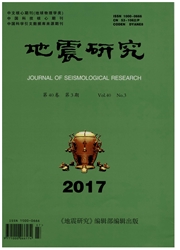

 中文摘要:
中文摘要:
统计分析了汶川地震滑坡在不同影响因子下数量和密度,然后采用归一化方法确定影响地震滑坡的关键因子。基于关键因子建立了地震滑坡密度数学模型。结果表明:从滑坡数量看,滑坡主要集中在(10°-20°)至(40°-50°)的坡度(90 m栅格)区间,主体集中在35°附近,在3°-7°之间有一个滑坡分布的小峰值;滑坡密度随着坡度的增加而增加,在3°-7°的低坡地带有一个滑坡密度小峰值,在坡度一定的情况下,除了烈度外,其他影响因子下滑坡密度并没有表现出足够明显的规律性变化;归一化计算结果表明:坡度和烈度是地震滑坡的关键因子;根据逻辑斯蒂模型计算的结果,将地震滑坡危险性分为几无(≤0.01)、轻微(0.01-0.03)、中等(0.03-0.09)、严重(0.09-0.27)、特重(≥0.27)5个等级。地震滑坡危险性预测数据在鲁甸地震等地震应急中发挥了较好作用。
 英文摘要:
英文摘要:
In order to quickly and accurately predict the risk of earthquake induced landslides after the earthquake, we count and analyze the quantity and the density ( which means the number of the landslide per unit area) of Wenchuan Ms8. 0 earthquake induced landslides in different impact factor, and determine the key factors of earth- quake induced landslides by normalization method. Then based on the key factors, we develop a mathematical model for the earthquake induced landslides frequency. Taking the landslides number as the main statistical standards, we find that the landslides are mainly concentrated in the slope of 10 -20° -40 -50°(based on the grid of 90 m), most landslides are concentrated in the slope of 35° and its nearby, and there is a small peak with landslides distribution in the slope of 3 ° - 7 °. The density of landslides increases with the increase of the slope, and there is a small peak of landslides density during the slope of 3 ° - 7°. If the slope remains unchanged, we find that landslides density do not show a regular variation with other factors except intensity. The normalized calculation results show that the slope and the intensity are the key factors of earthquake induced landslides. According to the calculation result of Logistic model, we divide the risk of earthquake induced landslides into 5 grades: Few (≤0.01), Low (0.01 -0.03), Medium (0.03-0.09), Critical (0.09-0.27) and Extra-heavy (≥0. 27) . Now, the predicting data of the risk of earthquake induced landslides has played a good role in Ludian M6.5 earthquake emergency.
 同期刊论文项目
同期刊论文项目
 同项目期刊论文
同项目期刊论文
 期刊信息
期刊信息
